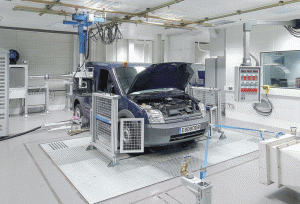Ford is measuring the ambient relative humidity (RH) within its testing bays, at the Dunton Technical Centre in Dunton, Essex, with Sontay’s SonNet wireless sensor system.
Ford’s Dunton Technical Centre is one of Europe’s largest automotive R&D centres and employs around 3,000 people. Engineers at the facility regularly conduct emission tests and, so they can reach optimum efficiency when running the vehicle, the relative humidity of the testing bays needs to be measured.
 When testing vehicles, Ford needs to ensure the ambient RH is measured and controlled by the Building Management System (BMS) so it does not interfere with its own tests. If the required ambient RH figures are not met the tests can be deemed to fail, so it is extremely important for Ford to have a sensor system that is reliable and accurate.
When testing vehicles, Ford needs to ensure the ambient RH is measured and controlled by the Building Management System (BMS) so it does not interfere with its own tests. If the required ambient RH figures are not met the tests can be deemed to fail, so it is extremely important for Ford to have a sensor system that is reliable and accurate.
In this constantly changing environment, it was vital for Ford to be able to install sensors that could be quickly and easily moved and re-positioned as necessary so wireless was the perfect solution.
Part of the testing process often includes moving equipment that generates heat around the vehicles under test, meaning it can be hard to monitor the ambient RH of the bays. Therefore, sensors are required to be moved around to ensure the ambient RH readings are accurate. As wired sensors are difficult to re-locate quickly, the SonNet wireless system was the obvious choice for building controls specialists, Schneider Electric.
Following a detailed site survey, fully supported by Sontay’s field representative, Schneider Electric were able to prove that the equipment would work correctly prior to installation and installed three sensors within the testing bays.
“The survey was very comprehensive” comments Peter Wright, Support Engineer at Schneider Electric and based at the Ford Dunton Technical Centre. “The representative from Sontay had a good knowledge of the equipment and gave good advice about how to site it. The installation was simple and connection to the local BMS system was hassle free.”
Since sensor operation is based on the latest 2.4GHz licence free radio technology, specifying SonNet sensors eliminated the need for Schneider Electric to run any structured cabling to the products, making it a quick and easy process.
Operationally, the SonNet radio receiver converts transmitted data from the sensors to analogue outputs (compatible with most control systems). The receiver is available with 20 channels, as standard, and up to 40, with the addition of an optional 20 way Daughter Board. Due to the nature of the site, having a secure wireless system was of paramount importance. Sontay was able to reassure Ford that the SonNet system is extremely secure and the sensors run a self-healing tree application for maximum reliability, operation and battery life. This ensures robust ‘fit and forget’ communications with lower installed project costs.
Peter continues: “Sontay had a complete system which suited our needs and I knew it would be compatible with the building management system onsite. With the software the company provides, the system is extremely easy to install and commission. I like the feature on the Base Station that allows you to monitor the battery life of the wireless sensors and each one can be renamed to suit our requirements, which is really helpful.”
